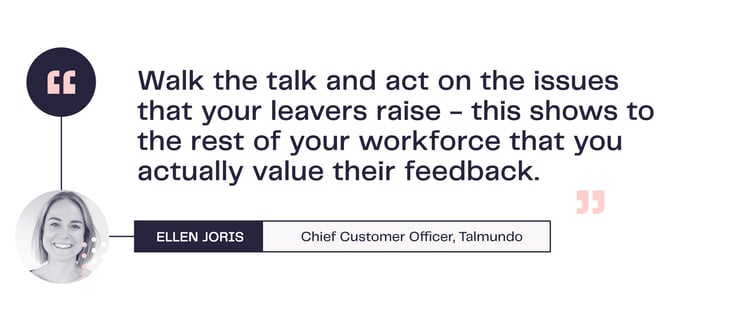Offboarding is not a new thing, but in recent years the process has become increasingly formalized, better understood, and more widely adopted.
Unfortunately, many organizations are still in the dark when it comes to GOOD exit management. They know it’s important, but they lack the resources and support to implement a successful, best-practice-led journey.
Getting it wrong can have far-reaching consequences, including poor company reviews, low staff morale, negative impacts on talent attraction and recruitment, and more.
Luckily, our resident Talmundo offboarding expert, Ellen Joris, is here to set the record straight on GOOD exit management.
Let’s dive in!

Ellen Joris is the Chief Customer Officer at Talmundo. In her four years with us, she has established her reputation as a best-practice expert in employee transitions including onboarding and offboarding.
Jesse: Why do you think a structured exit management strategy is important?
Ellen: Honestly, there are so many reasons.
There’s the very real war for talent - people who rejoin a former employer after spending some time elsewhere aren’t an exception anymore. In these cases, exit management is as much a part of your employer brand strategy as recruitment & onboarding.
Today alumni programs are a great source for new employee referrals and only work if your former team members are ambassadors for your brand. Making sure they have the goodbye they deserve plays a big role there.
A streamlined process for knowledge transfer is also key, both for maintaining business continuity and for offering whoever’s replacing the leaver a good onboarding experience.
And finally, since leavers don’t really have anything ‘left to lose’, they’re a great source of feedback on what could be improved in your company.
J: Many HR professionals know that offboarding is important, but struggle to put together an effective program. What do you think a GOOD offboarding experience looks like?
E: Good offboarding should strike a balance between compliance & administration and giving your employee the goodbye they deserve.
Knowledge transfer and the safeguarding of company assets are a vital part of exit management, but making sure someone has their final say about their time at your company and moves on to a new challenge with a good feeling about their former employer, are just as important.
Of course, it’s also key to walk the talk and to act on the issues that your leavers raise - this shows to the rest of your workforce that you actually value their feedback.

J: Great insights! Could you tell us a little more about barriers to good offboarding? What are some of the big challenges your clients are facing?
E: Sure thing! What we see most often is that many organizations struggle to build a process that goes beyond the bare minimum of compliance and reclaiming company assets.
For those who DO have a more developed program and are already gathering data on why people are leaving, it can be a real challenge to analyze that data & act on it.
Time is also a huge factor. HR usually has a lot of different tasks & projects to run with limited resources, and exit management is often last on the priority list.
Managers also play a vital role in a good exit management strategy, and can help ease the burden on HR - but getting them on board can prove to be a challenge…
J: How can organizations overcome these hurdles?
E: The first step toward better exit management processes is acknowledging that there is value to be added by investing in this final employee lifecycle stage.
Once you’ve accepted that, you start small. Don’t try to tackle everything at once, especially if the resources at your disposal are limited. Pick one thing that you feel would greatly improve the offboarding experience, and focus on doing that really well. Once it becomes a fixed part of your process and you have more time, you can add something else.
Long-term success requires digital support to automate (some of) the process - taking the strain off of HR and making your process scalable and future-proof.
J: Do you think the pandemic has changed the way organizations look at exit management?
E: I’m afraid COVID might have had a negative impact on exit management.
People have been working from home for the greater part of a year, companies were dealing with other challenges, and leavers have become very easy to overlook.
Remote management is new to many people and it’s easy to lose touch, so when someone decides to leave, exit interviews and goodbye parties are often skipped, and HR focuses on the bare minimum.
We do also see a slightly higher turnover in some markets, so I do think companies will realize that they need to learn from the feedback that leavers give and that as potential ambassadors everyone deserves a proper goodbye.
J: OK, so lots to be learned! How about offboarding horror stories, do you have any of those?
E: The worst I’ve seen is people being completely ignored & even ostracized after announcing they would leave. No dignified goodbye, no chance at a final say.
Needless to say that this makes for a horrible offboarding experience for the leaver who will not have fond memories of their former employer, and as a company, you don’t learn anything from it to improve your processes.
J: Not exactly a thrilling end to your tenure.
E: Exactly. It’s a clear lose-lose situation.
J: Alright, last question, let’s end on a high note - what’s something BRAND NEW in the offboarding space that HR professionals may not have heard about?
E: It’s not a new feature or tool, but just the fact that offboarding can be as big a part of your employer brand as onboarding is.
The way you deal with people leaving your company can turn them into real ambassadors for your brand, and it also sends a very positive message to the people still working at your company, which again confirms that you’re an employer looking to improve & grow.
 |
The Takeaway |
The first step toward a good exit management process is to understand not only that it IS important, but WHY it is important.
Consider the impact that a positive leaving experience can have, not only for departing employees but for your business as a whole.
Start seeing the leaving process as an opportunity for growth and future wins, instead of another ‘problem’ to be solved.
Then (and only then) can you start building a successful offboarding program that will safeguard business continuity for years to come.
Ready to get started with digital offboarding?
Join our webinar and learn how to create powerful processes that tackle the main types of offboarding, from retirement to resignation!






